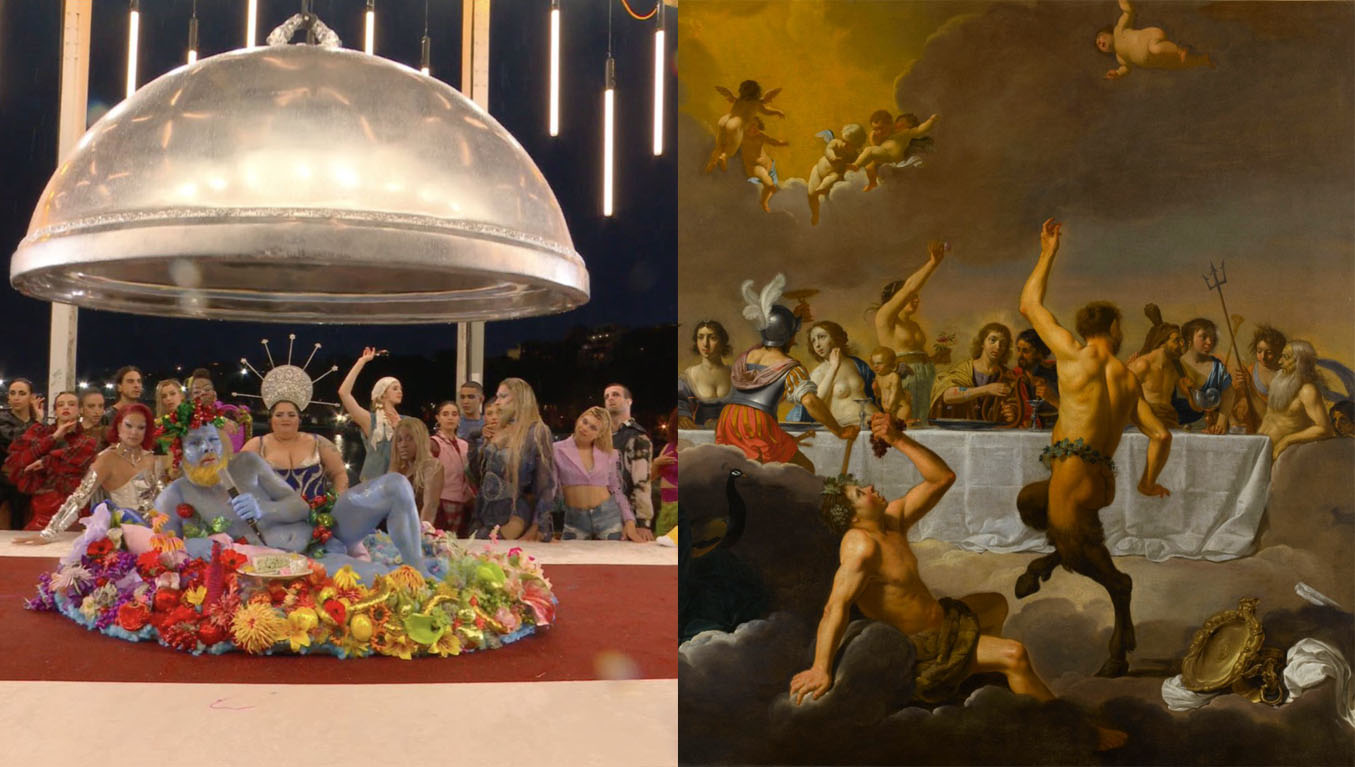The Feast of Dionysus is a captivating theme in art, celebrating the ancient Greek god of wine, revelry, and theater. Artists across centuries have depicted this grand festivity, where Dionysus, surrounded by satyrs, maenads, and gods, indulges in the pleasures of life.
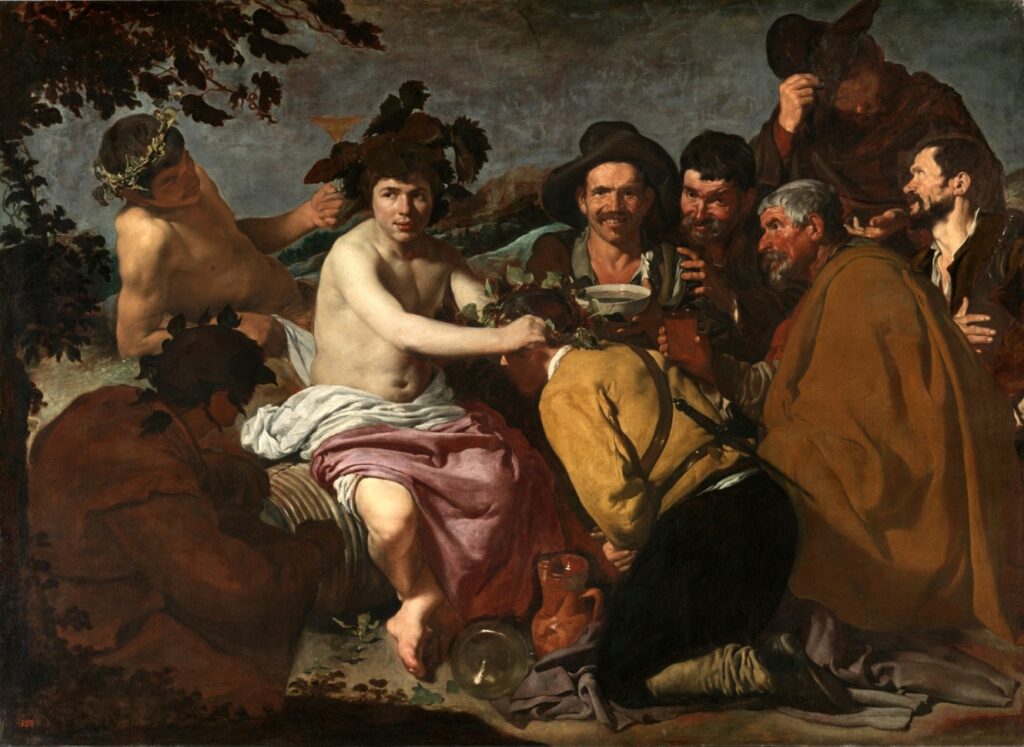
The Triumph of Bacchus by Diego Velázquez (1628-1629)
This blog post explores the Feast of Dionysus Painting and the 2024 Olympics, analyzing its artistic elements, symbolism, and historical context. We will also discuss how this theme compares to the Feast of the Gods painting and other Dionysian representations in art history, including its influence on the Paris Olympics 2024 Bacchus performance.
The Feast of Dionysus Painting and the 2024 Olympics: Bacchus’ Influence

2024 Paris Olympics Opening Ceremony
The 2024 Paris Olympics Opening Ceremony sparked widespread discussion when it featured a striking artistic reenactment of Greek gods celebrating atop Mount Olympus. The performance, starring French actor and singer Philippe Katerine as Bacchus, was mistakenly interpreted by some critics as a parody of The Last Supper. However, this theatrical spectacle was actually a direct reference to the centuries-old artistic tradition of divine feasting seen throughout Western art history.
Directed by Artistic Director Thomas Jolly, the performance—titled Festivity—featured drag artists, dancers, and other performers in elaborate Greek-inspired costumes. The central moment occurred when a large dinner platter was lifted to reveal Bacchus, god of wine and revelry, dressed in blue, exuding a spirit of excess and divine pleasure.
Jolly clarified that the depiction of Bacchus aligns with his mythological role as the god of celebration, directly tying into France’s rich winemaking heritage and the cultural legacy of the Seine River’s goddess, Séquana. The scene was not unique in its interpretation; rather, it echoed a well-documented history of Bacchanalian feasts in European painting, particularly from the 16th and 17th centuries.
The Feast of Dionysus in Western Art
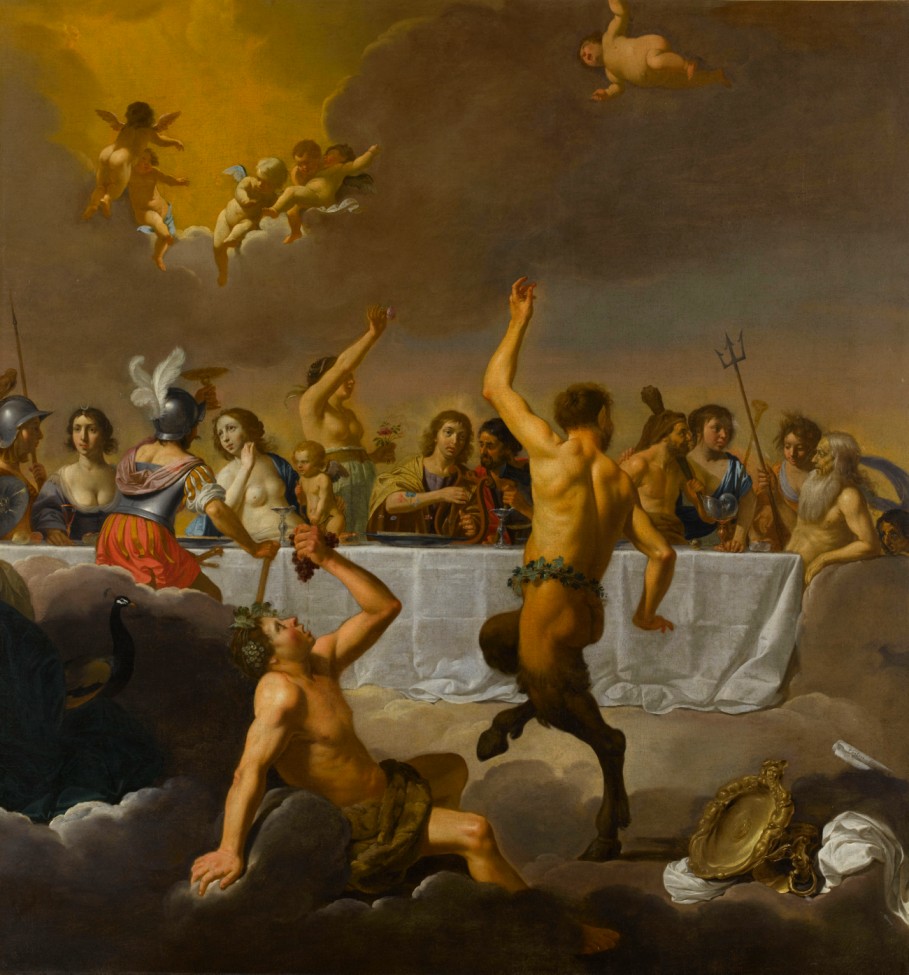
Jan Harmensz van Biljert’s “The Feast of the Gods” (c. 1635–40)
The theme of Dionysian feasts and gods’ banquets has been a prominent subject in art for centuries. One of the most frequently cited examples during the Olympics controversy was Jan Harmensz van Biljert’s “The Feast of the Gods” (c. 1635–40), housed in the Musée Magnin in Dijon, France. The painting portrays a grand banquet on Mount Olympus, commemorating the marriage of Peleus and Thetis, the event that indirectly set the stage for the Trojan War.
Notable Examples of Dionysian Feasts in Art:
“The Feast of the Gods” (1514/29) – Giovanni Bellini & Titian

A famous Renaissance masterpiece that highlights divine indulgence and excess.
“A Banquet of the Gods” – Joachim Wtewael

A lively Dutch Mannerist painting, featuring a drunken Bacchus reveling among other deities.
“The Triumph of Bacchus” (1628–1629) – Diego Velázquez

This Baroque painting depicts Bacchus presenting wine to mortals, blending realism with mythology.
“The Feast of Bacchus” (1640) – Jan Brueghel the Younger

Showcases Bacchus crowned with ivy and holding a glass of wine, surrounded by deities and revelers.
“The Triumph of Bacchus” – Ciro Ferri

A grand Baroque depiction of Bacchus in a golden chariot pulled by leopards, accompanied by satyrs and maenads.
These paintings emphasize Dionysian iconography—wine, garlands of ivy, ecstatic dance, and divine revelry—elements that were mirrored in the Paris Olympics performance.
Symbolism in the Feast of Dionysus Paintings
Throughout history, Bacchus and Dionysus paintings have conveyed themes of pleasure, transformation, and unbridled joy. Some of the key symbols commonly found in these artworks include:
Grapevines & Wine: Representing fertility, transformation, and divine celebration.
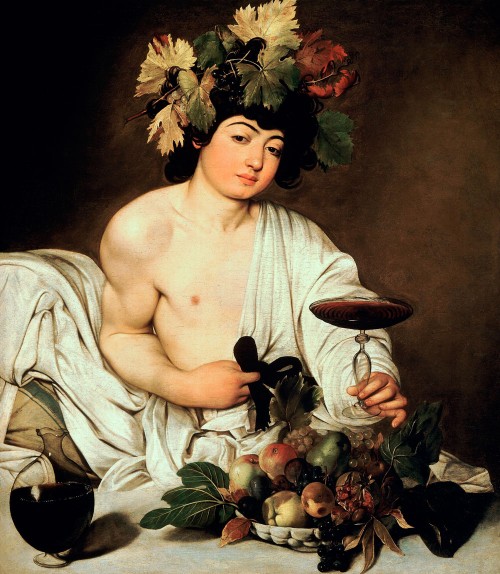
Caravaggio’s ‘Bacchus’ (1595)
Leopards & Chariots: Bacchus’ divine power and connection to wild, untamed nature.

Golden Goblets & Banquets: Symbols of abundance, indulgence, and divine generosity.

Satyrs & Maenads: Devoted followers of Dionysus, representing ecstatic spiritual liberation.
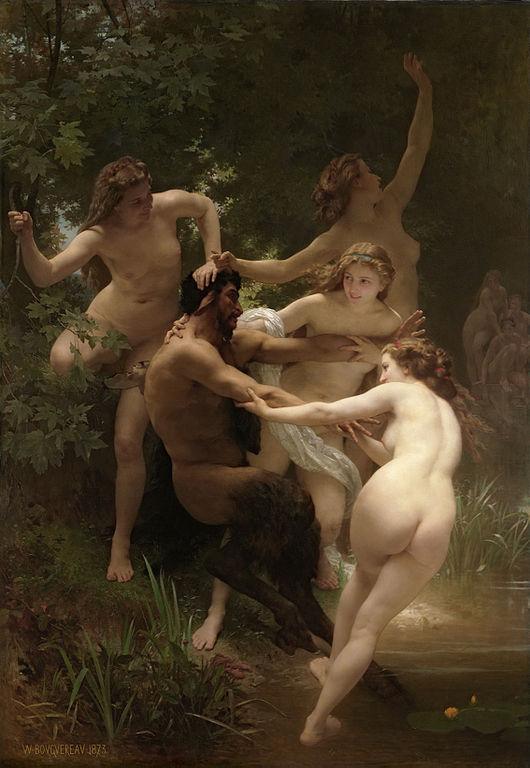
Nymphs and Satyr” (1873) by William-Adolphe Bouguereau
The Thyrsus: A staff topped with ivy and pinecones, representing Bacchic power and frenzied inspiration.

A Bacchante Holding a Thyrsus Lying in a Classical Interior by Cesare Ciani
Influence on Modern Art and Popular Culture
The Dionysian feast motif continues to inspire modern artists, filmmakers, and performers. The 2024 Olympics performance is only the latest example of how mythology continues to shape contemporary artistic expression. The Florence Bacchus Incident, where a tourist recently climbed onto a statue of Bacchus, also shows how the god’s legacy remains embedded in cultural consciousness.
Alternative Surrealist Recommendations for Bacchanalian Feasts:
If you’re looking for a surrealist take on Bacchic revelry, consider these alternative Dalí paintings that feature similar themes of indulgence, wine, and divine ecstasy:
“The Sacrament of the Last Supper” (1955) – Salvador Dalí
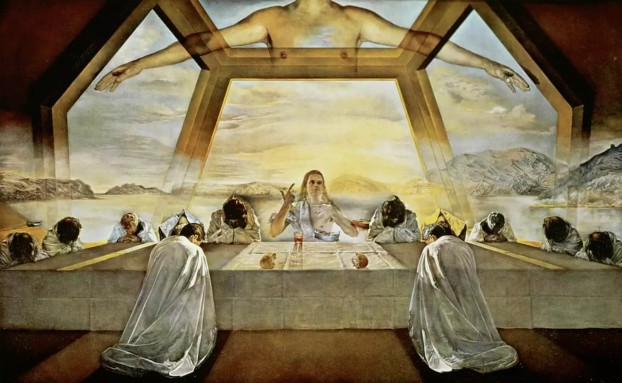
Although it’s not a Bacchus feast, it blends divinity, feasting, and surrealistic elements, making it a great visual metaphor for the excesses of Dionysian feasts.
It has a dreamlike, larger-than-life banquet feel.
“The Temptation of Saint Anthony” (1946) – Salvador Dalí

Features floating figures, wild animal symbolism, and excess, which can be associated with Dionysian temptations.
Elephants carrying heavy loads resemble the divine processions of Bacchus, who often appears carried by animals.
“Debris of an Automobile Giving Birth to a Blind Horse Biting a Telephone” (1938) – Salvador Dalí

This lesser-known surrealist piece features chaotic, distorted forms, symbolizing excess, indulgence, and intoxication, much like Bacchic frenzies.
If you need a more direct Bacchanalian feast painting from surrealist artists, consider:
“Bacchanal” (1959) – André Masson (A surrealist interpretation of Bacchus and wild revelry)
“The Bacchanale” (1939) – Pablo Picasso (Expressionist-Surrealist Bacchic dance scene)
Related Contemporary Works:
Salvador Dalí – Surrealist interpretations of Dionysian feasts.
Neo-Expressionist Art – Modern depictions of Bacchanalian excess.
Cinematic References – Films like Fellini’s Satyricon and Baz Luhrmann’s The Great Gatsby incorporate elements of Dionysian revelry.
Conclusion
The Feast of Dionysus painting remains an enduring subject, appearing from Renaissance masterpieces to modern artistic spectacles like the Paris Olympics Opening Ceremony. Whether through classical paintings, theatrical performances, or contemporary media, the theme of divine feasting continues to captivate audiences and spark discussions about art, mythology, and cultural expression.
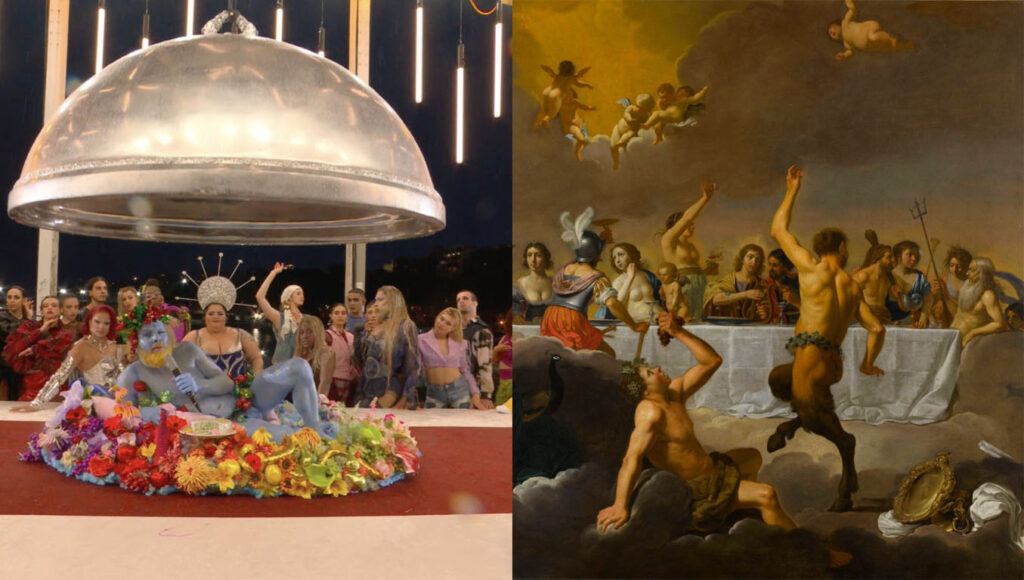
- Visit museums featuring Dionysian artworks.
- Learn more about Greek and Roman mythology in art history courses.
- Follow Artistic Masterclass for deeper insights into art movements, symbolism, and artistic traditions.

